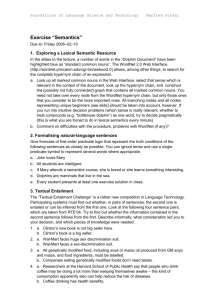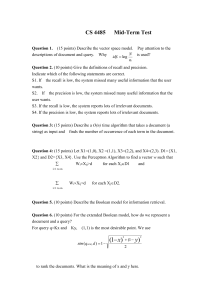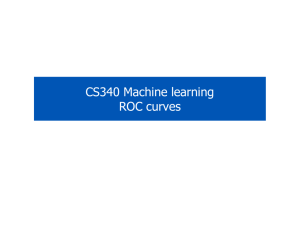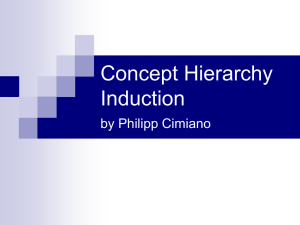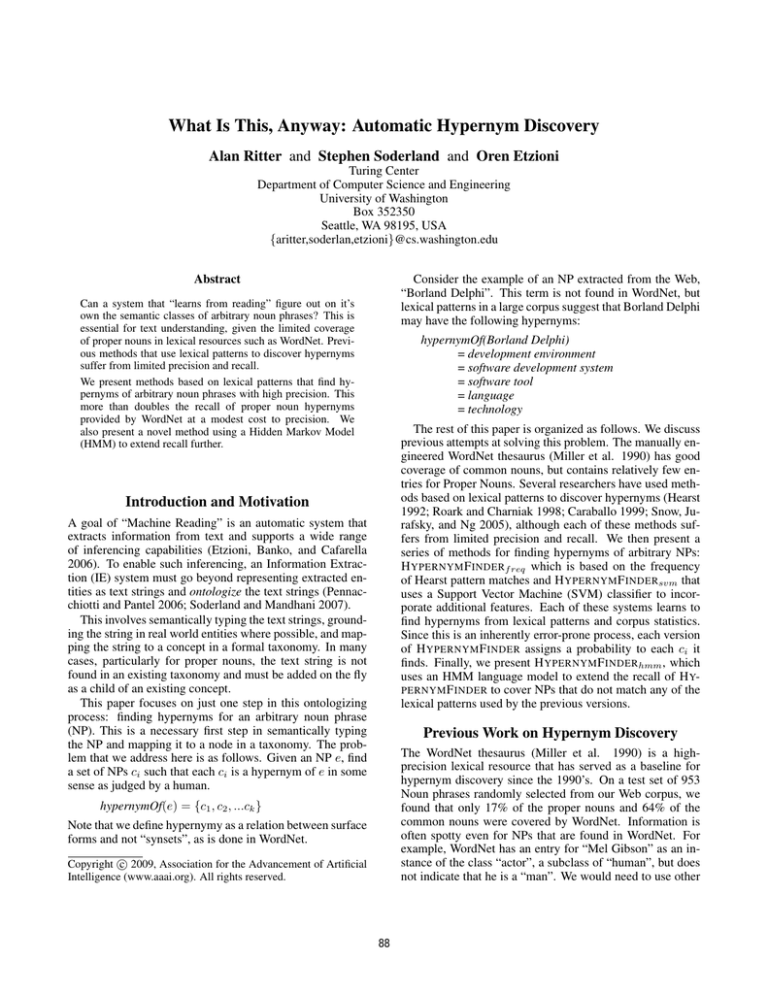
What Is This, Anyway: Automatic Hypernym Discovery
Alan Ritter and Stephen Soderland and Oren Etzioni
Turing Center
Department of Computer Science and Engineering
University of Washington
Box 352350
Seattle, WA 98195, USA
{aritter,soderlan,etzioni}@cs.washington.edu
Consider the example of an NP extracted from the Web,
“Borland Delphi”. This term is not found in WordNet, but
lexical patterns in a large corpus suggest that Borland Delphi
may have the following hypernyms:
Abstract
Can a system that “learns from reading” figure out on it’s
own the semantic classes of arbitrary noun phrases? This is
essential for text understanding, given the limited coverage
of proper nouns in lexical resources such as WordNet. Previous methods that use lexical patterns to discover hypernyms
suffer from limited precision and recall.
We present methods based on lexical patterns that find hypernyms of arbitrary noun phrases with high precision. This
more than doubles the recall of proper noun hypernyms
provided by WordNet at a modest cost to precision. We
also present a novel method using a Hidden Markov Model
(HMM) to extend recall further.
hypernymOf(Borland Delphi)
= development environment
= software development system
= software tool
= language
= technology
The rest of this paper is organized as follows. We discuss
previous attempts at solving this problem. The manually engineered WordNet thesaurus (Miller et al. 1990) has good
coverage of common nouns, but contains relatively few entries for Proper Nouns. Several researchers have used methods based on lexical patterns to discover hypernyms (Hearst
1992; Roark and Charniak 1998; Caraballo 1999; Snow, Jurafsky, and Ng 2005), although each of these methods suffers from limited precision and recall. We then present a
series of methods for finding hypernyms of arbitrary NPs:
H YPERNYM F INDERf req which is based on the frequency
of Hearst pattern matches and H YPERNYM F INDERsvm that
uses a Support Vector Machine (SVM) classifier to incorporate additional features. Each of these systems learns to
find hypernyms from lexical patterns and corpus statistics.
Since this is an inherently error-prone process, each version
of H YPERNYM F INDER assigns a probability to each ci it
finds. Finally, we present H YPERNYM F INDERhmm , which
uses an HMM language model to extend the recall of H YPERNYM F INDER to cover NPs that do not match any of the
lexical patterns used by the previous versions.
Introduction and Motivation
A goal of “Machine Reading” is an automatic system that
extracts information from text and supports a wide range
of inferencing capabilities (Etzioni, Banko, and Cafarella
2006). To enable such inferencing, an Information Extraction (IE) system must go beyond representing extracted entities as text strings and ontologize the text strings (Pennacchiotti and Pantel 2006; Soderland and Mandhani 2007).
This involves semantically typing the text strings, grounding the string in real world entities where possible, and mapping the string to a concept in a formal taxonomy. In many
cases, particularly for proper nouns, the text string is not
found in an existing taxonomy and must be added on the fly
as a child of an existing concept.
This paper focuses on just one step in this ontologizing
process: finding hypernyms for an arbitrary noun phrase
(NP). This is a necessary first step in semantically typing
the NP and mapping it to a node in a taxonomy. The problem that we address here is as follows. Given an NP e, find
a set of NPs ci such that each ci is a hypernym of e in some
sense as judged by a human.
Previous Work on Hypernym Discovery
The WordNet thesaurus (Miller et al. 1990) is a highprecision lexical resource that has served as a baseline for
hypernym discovery since the 1990’s. On a test set of 953
Noun phrases randomly selected from our Web corpus, we
found that only 17% of the proper nouns and 64% of the
common nouns were covered by WordNet. Information is
often spotty even for NPs that are found in WordNet. For
example, WordNet has an entry for “Mel Gibson” as an instance of the class “actor”, a subclass of “human”, but does
not indicate that he is a “man”. We would need to use other
hypernymOf(e) = {c1 , c2 , ...ck }
Note that we define hypernymy as a relation between surface
forms and not “synsets”, as is done in WordNet.
c 2009, Association for the Advancement of Artificial
Copyright Intelligence (www.aaai.org). All rights reserved.
88
knowledge sources or extractions from a corpus to find that
Mr. Gibson is also an instance of “movie star”, “Australian”,
or “Catholic”.
Some of the earliest research in automatically discovering
hypernyms from text was by Hearst (1992). She presented
the manually discovered lexical patterns listed in Figure 1
that detect hypernyms. These patterns are fairly good evidence that the entity E is a subclass or member of C. For
the remainder of this paper, we will refer to these patterns as
the Hearst patterns.
Snow, Jurafsky, and Ng (2005) induced a large number
of weak patterns to detect hypernyms, using WordNet to
automatically tag pairs of NPs from a corpus of 6 million
newswire sentences. They then built a classifier using nearly
70,000 of these patterns and the frequency that each pattern
occurs for a given pair of noun phrases in their corpus. Most
of the patterns gave very weak evidence of a hypernym relation. The Hearst patterns, which were among those induced,
were among the highest precision patterns.
Snow et al. found that their classifier outperformed a
baseline of simply looking for a single occurrence of a
Hearst pattern and also outperformed a WordNet classifier. They evaluated their classifier on a set of 5,300 handtagged pairs of NPs taken from random paragraphs in their
newswire corpus. Their recall-precision graph indicates precision 0.85 at recall 0.10 and precision 0.25 at recall of 0.30
for their hypernym classifier. A variant of their classifier that
included evidence from coordinate terms (terms with common ancestor classes) also had precision 0.85 at recall 0.10
but increased precision to 0.35 at recall 0.30.
More recently, (McNamee et al. 2008) applied the techniques described in (Snow, Jurafsky, and Ng 2005) to detecting hypernyms of Named Entities (i.e. Proper Nouns) in
order to improve performance of Question Answering systems. Their corpus consisted of about 16 million sentences
which was larger than that used by Snow et. al, but still
an order of magnitude smaller than the corpus used in this
work. They obtained 53% mean average precision on automatically detected hyponyms of 75 categories. Their automatically discovered hyponyms resulted in a 9% boost in
performance on a TREC Question Answering data set.
E is a C
E [,] and other C
E [,] or other C
C [,] such as E
C [,] including E
C [,] especially E
such C as E
Figure 1: The “Hearst patterns”: Lexical patterns that predict that entity E belongs to class C.
The Hearst patterns suffer from limited recall – not all
pairs <E,C> will be found in such patterns. Also, due to
the local nature of the patterns, they inevitably make errors.
A sentence with
“... urban birds in cities such as pigeons ...”
matches the pattern “C such as E” with C bound to city and
E bound to pigeon, leading to city as a hypernym of pigeon.
We made use of the Hearst patterns in our IE systems,
K NOW I TA LL (Etzioni et al. 2004a; 2004b; 2005) and T EX T RUNNER (Banko et al. 2007). We found that we needed to
refine the rules somewhat. We increased recall by replacing
the NP E with a list of NPs for most patterns. For example,
the pattern “C [,] such as NList” would identify k NPs with
hypernym C when N List is a list of k simple NPs.
We also found that some patterns only have high precision when the class name is identified as a plural noun by a
statistical part of speech tagger.
Exploiting Lexico-syntactic Patterns
Our goal is an efficient, practical H YPERNYM F INDER that
takes an arbitrary NP e and returns a ranked list of up to k
terms that are hypernyms of e for any sense of e. We first
present H YPERNYM F INDERf req , a classifier based on the
frequency of Hearst pattern matches.
Then we present H YPERNYM F INDERsvm that combines
a variety of features using an SVM classifier to distinguish
the correct hypernyms from among matches to the Hearst
patterns. Later we explore methods that extend recall beyond hypernyms found by the Hearst patterns.
Correct match on plural class name:
“Developing countries such as China
and India have emerged ...”
⇒ hypernymOf(China) = country
⇒ hypernymOf(India) = country
Frequency-based Classifiers
Error from singular class name:
“I like to listen to country such as
Garth Brooks.”
⇒ hypernymOf(Garth Brooks) = country
As a first step in building each of the following versions of
H YPERNYM F INDER, we ran T EXT RUNNER on corpus of
117 million Web pages and recorded candidate hypernym
pairs that matched any of the Hearst patterns. For each
of these pairs of noun phrases <e, c> we counted the frequency of matches from distinct sentences for each Hearst
pattern.
Although the precision of a candidate hypernym generally
correlates with the frequency of pattern matches, we found
that even very high frequency candidates are often errors.
Simply setting a threshold on frequency is not sufficient to
obtain high precision.
The accuracy of proposed hypernyms is correlated with
extraction frequency, the number of distinct sentences that
match a Hearst pattern. We estimated that, on a corpus of
117 million Web pages, hypernyms with frequency 1 had
accuracy of 30% for common nouns and 49% for proper
nouns. With a frequency ≥ 40, the accuracy increased to
86% (at recall less than 0.03) for common nouns and accuracy of 87% (at recall 0.01) for proper nouns.
89
0.8
0.6
0.4
0.2
C.
frequency
1 left and 1 right
0.0
B.
“... all around the world including
Australia, ...”
⇒ hypernymOf(Australia) = world
“... information about this hotel
such as rates, ...”
⇒ hypernymOf(rates) = hotel
“... first prize is a trip to ...”
⇒ hypernymOf(prize) = trip
precision
A.
1.0
The reason for this is the local nature of the Hearst patterns, which means that they can be fooled by certain sentence structures that occur with high frequency. Here are
some examples of high frequency matches on Hearst patterns that produce incorrect hypernyms.
Figure 2: Certain sentence structures that cause errors match
Hearst patterns with high frequency. Fortunately, most of
these sentence structures match only “right” patterns (as in
A and B) or only “left” patterns (as in C). High precision
can be obtained by filtering out hypernyms that do not have
at least one right and one left pattern.
0.0
0.2
0.4
0.6
0.8
1.0
recall
Figure 3: Ranking hypernyms by the frequency of Hearst
pattern matches covers 66% of the NPs in our test set. Filtering these hypernyms to require at least one “left” and one
“right” pattern gives a boost in precision.
Most of these high frequency errors occur only with
“right” patterns (where e comes to the right of c) or only
with “left” patterns (where e comes to the left of c). Precision is improved by requiring at least one match on both
right and left pattern.
Figure 3 compares the recall-precision curve for two
methods of using Hearst pattern frequencies to find hypernyms. Both methods rank the proposed hypernyms by the
number of distinct sentences that match a Hearst pattern.
The baseline frequency method simply ranks by total pattern matches. The filtered frequency method (labeled as “1
left and 1 right”) assigns low probability to any proposed hypernyms that are not found in at least one right pattern and
at least one left pattern.
For this and each of the other experiments, we used a test
set of 953 well-formed simple NPs e that were randomly
selected from T EXT RUNNER extractions from a corpus of
117 million Web pages. We had each method output up to
k = 5 proposed hypernyms for each e. We hand-tagged the
proposed hypernyms as correct, incorrect, or vague.
We compute recall in these experiments as the percentage
of NPs in the test set that are “covered” by each method –
those NPs for which at least one correct hypernym is found.
Precision is the total number of correct hypernyms divided
by the total number of guessed hypernyms (up to a maximum of 5 for each e). Note that this differs from the method
used to compute Precision and recall used by (Snow, Jurafsky, and Ng 2005). Their method computed precision and
recall over candidate hypernym/hyponym word pairs. In
contrast we are more concerned with whether or not we can
find a good hypernym for a given noun phrase.
The precision-recall curve for the baseline frequency
method has recall 0.11 at precision 0.90 after an initial dip
below 0.90 at recall 0.02. The filtered frequency method
avoids this initial dip in precision and reaches recall 0.23
at precision 0.90, more than twice the recall of the baseline
method. Each method reaches recall of 0.66 at precision
0.64.
Note that there is a limit in recall for any method built on
the Hearst patterns – about 1/3 of the noun phrases in our
test set do not occur in any Hearst patterns in our large web
corpus.
Combining Evidence with SVM
Although simple rules based on extraction frequency and
the existence of both right and left patterns proved surprisingly effective, there are other types of evidence that
can help distinguish correct hypernyms.
We created
H YPERNYM F INDERsvm that uses an SVM classifier to assign a probability of correctness (Platt 1999) to a proposed
hypernym pair <e, c> that has matched at least one Hearst
pattern on a large text corpus.
We used the following features to classify the proposed
hypernym <e, c>:
•
•
•
•
•
Total number of distinct pattern matches.
Total number of left pattern matches.
Total number of right pattern matches.
Total number of matches for “e is a c”.
Fraction of matches e which follow articles, determiners,
or quantifiers.
• The rank by frequency among hypernyms of e.
While frequency is the best indicator of hypernym correctness, we wanted to combine this flexibly with other
weaker evidence. Our rule-based classifier filtered out proposed hypernyms where either left or right pattern matches
had zero frequency, but this is a bit extreme. Many hypernyms with unbalanced left-right patterns are actually correct.
90
We included the frequency of matches on “e is a c” because this is somewhat less reliable than the other patterns.
The ratio of e which follow articles, determiners and quantifiers helps avoid matches on sentences such as “Our dog
is a bloodhound ...”. This does not imply that all dogs are
bloodhounds.
We trained a Support Vector Machine (SVM) classifier on
hand-labeled data using 10 fold cross validation. For these
experiments, we split the test referenced earlier into a set
of 583 proper nouns and a set of 370 common nouns, and
evaluated each set separately 1 .
We consider a pair of NPs <e, c> in our test sets as correct if e belongs to the class c for some sense of e. Thus
the entity “cedar” has hypernyms “wood”, “softwood”, and
“material” for one sense of cedar, and also has hypernyms
“tree” and “conifer” for another sense. We let each method
output up to 5 hypernyms for each NP in the test set.
WordNet is a baseline for high-precision hypernyms – if
a word is found in WordNet, it is guaranteed to have at
least one hypernym. By our definition of correct hypernyms,
WordNet has nearly perfect precision. So a practical hypernym finder would first look up a word in WordNet, before
augmenting this with other methods.
In the remainder of the experiments, we begin by looking up each e in WordNet and consider the words found in
WordNet to be “covered” with at least one correct hypernym. Thus, each of our recall-precision curves starts at recall 0.17 and precision 1.00 for proper nouns, and starts at
recall 0.64 and precision 1.00 for common nouns. These
represent the words found in WordNet. We found 43% of
the proper nouns and 9% of the common nouns which were
covered by WordNet to be multi-word phrases. Our interest
is in extending the recall to words not in WordNet.
As in earlier experiments, we count recall as the number
of e for which at least one correct hypernym c is found. Precision is computed as the fraction of c which are correct.
Figures 4 and 5 present results for proper nouns and common nouns, respectively. The lines labeled “Rule-based
Classifier” are for the filtered frequency implementation of
H YPERNYM F INDERf req Ṫhe lines labeled “SVM” are from
H YPERNYM F INDERsvm using the features enumerated in
this section.
A simple WordNet lookup covers 17% of proper nouns.
H YPERNYM F INDERf req extends the recall to 0.32 at precision 0.90 and recall 0.65 at precision 0.64. The curve
for H YPERNYM F INDERsvm is consistently higher than for
H YPERNYM F INDERf req and has recall 0.37 at precision
0.90 and a higher precision of 0.73 at the tail of the curve.
There was less room for improvement over WordNet
for common nouns, of which WordNet covers 64%. Here
H YPERNYM F INDERf req extends recall to 0.67 at precision
0.90 and gives recall of 0.80 at precision 0.61. Again,
the curve for H YPERNYM F INDERsvm is consistently higher
than for H YPERNYM F INDERf req with recall 0.70 at precision 0.90.
These methods are straightforward ways to find hyper-
0.6
0.4
0.2
precision
0.8
1.0
Proper Nouns
0.0
Rule−based classifier
SVM
SVM + HMM−T classifier
0.0
0.2
0.4
0.6
0.8
1.0
percentage of entities with one or more good hypernym
Figure 4: Each of our methods extends recall for proper
nouns far beyond the recall of 0.17 from WordNet lookup.
An SVM classifier uniformly raises precision over simple
rules using Hearst pattern frequency. Adding an HMM language model extends recall even further.
nyms for arbitrary proper nouns that extend recall beyond
that of WordNet, particularly the SVM classifier, with a
graceful decline in precision at higher recall. Yet these results are limited by the coverage of Hearst patterns. For
20% of the common nouns and 36% of the proper nouns
in our test set, there were no matches of Hearst patterns that
give a correct hypernym. In the following section, we describe experiments to extend the coverage of our H YPER NYM F INDER to find hypernyms for some of these NPs that
are beyond the reach of Hearst patterns.
Extending Recall Beyond Patterns
Here is the intuition of our approach to extending recall beyond the Hearst patterns. If we cannot find hypernyms for
entity e using the methods presented thus far, perhaps we
can find a sufficiently similar entity e whose hypernyms we
know. Given a good similarity metric, there should be a high
probability that e and e share the same hypernyms.
HMM Language Models
Inspired by R EALM (Downey, Schoenmackers, and Etzioni 2007) we investigated using Hidden Markov Models
(HMMs) (Rabiner 1989) as the similarity metric for another
version of H YPERNYM F INDER. R EALM uses HHMs to perform type checking of arguments in an open-domain IE system.
Given an HMM with n hidden states, which has been
trained to model the generation of our corpus, we can compute the probability that each NP is generated by each of the
1
56% of the proper nouns and 27% of the common nouns were
multi-word phrases
91
H YPERNYM F INDERcoord uses HMM hidden state distribution as features to find potential hypernyms c for an arbitrary NP e as follows. Rather than compute the probability
that c is a hypernym of e, this classifier computes the probability that e has a coordinate term e that is a hyponym of
c.
The H YPERNYM F INDERcoord increased the pool of proposed hypernym pairs <e, c>, but had relatively low precision. Just because two NPs have highly similar context does
not necessarily mean that they share the same hypernyms.
We had the highest precision for the more coarse-grained
classes such as person, organization, and region. For that
reason, we chose a relatively high level in the WordNet hierarchy as a cutoff (6 levels from the top).
We also set a threshold on the HMM similarity metric, so
H YPERNYM F INDERcoord only outputs <e, c> if it finds a
highly similar e such that e is a hyponym of a high-level
WordNet class c. We experimented with various weights to
combined the probabilities and found the best results on our
test set to be where H YPERNYM F INDERsvm had weight 0.8
and H YPERNYM F INDERcoord had weight 0.2.
The result of these settings is shown in Figures 4
and 5 as “SVM + HMM-T classifier”. For both common nouns and proper nouns, adding evidence from
H YPERNYM F INDERcoord extends the curve to the right.
This increases recall for common nouns from 0.80 to 0.82
and increases recall for proper nouns from 0.65 to 0.71.
Unfortunately,
in both cases the curve for
H YPERNYM F INDERhmm has an initial dip.
This is
because a term e with the most similar context to e is often
not actually a coordinate terms, so assigning the hypernyms
of e to e results in a error.
0.6
0.4
0.2
precision
0.8
1.0
Common Nouns
0.0
Rule−based classifier
SVM
SVM + HMM−T classifier
0.0
0.2
0.4
0.6
0.8
1.0
percentage of entities with one or more good hypernym
Figure 5: Performance on common nouns has qualitatively
similar results to that of proper nouns, but with a higher initial recall from WordNet and a smaller gain in recall from
our other methods.
HMM’s hidden states. This produces for each NP in our corpus, a vector of n probabilities that can be used as features
to a classifier or distance measure.
Downey et al. performed experiments that suggest that
HMMs produce better similarity measures than traditional
term-vector-based approaches. The intuitive argument for
this is that many coordinate terms (terms that share the
same hypernym) appear in similar, though not identical contexts. For example Pickerington and Chicago are coordinate
terms, because they share the common hypernym, City.
Now suppose that we see the following two contexts:
“Pickerington, Ohio”
“Chicago, Illinois”
These two contexts are not identical, so in a term-vectorbased similarity measure, they provide no evidence that
Pickerington and Chicago are coordinate terms. However
the two contexts, “· , Ohio” and “· , Illinois” are quite similar and so it is likely that they were generated by the same
hidden states in the HMM. So by viewing the hidden state
distribution of an HMM as context vectors, these two cities
have a high similarity given the above evidence.
Conclusions
We have presented a series of methods to find hypernyms of an arbitrary noun phrase e. These provide easyto-implement methods, the simplest of which requires no
tagged training. The main lessons we learned is that fairly
simple methods are sufficient to find hypernyms at high precision and with fairly high recall. This is particularly true
for proper nouns where our H YPERNYM F INDER more than
doubles the recall for proper nouns at precision 0.90 compared to looking up terms in WordNet. The gain in recall
is less for common nouns, where WordNet has coverage of
64%.
It is still an open question how best to extend recall beyond hypernyms that match one of the Hearst patterns, although we had some success in using an HMM language
model. Some of our future research in machine reading depends on finding hypernyms with high coverage and high
precision. We are inclined to try a hybrid approach – combine the methods presented here with using a named-entity
tagger to assign a coarse-grained class to proper nouns, using a large suite of weak hypernym patterns, and using lexical patterns as well as a language model to find coordinate
terms.
Using HMMs for Hypernym Discovery
We wish to create a H YPERNYM F INDERhmm that retains
the performance of H YPERNYM F INDERsvm on NPs that are
covered by Hearst patterns, but which additionally finds hypernyms for NPs that do not match any of the Hearst patterns in our corpus. This H YPERNYM F INDERhmm assigns
to each NP a probability that is a linear combination of the
probability from H YPERNYM F INDERsvm and the probability from a new classifier H YPERNYM F INDERcoord .
92
Acknowledgments
Roark, B., and Charniak, E. 1998. Noun-phrase cooccurence statistics for semi-automatic semantic lexicon
construction. In Procs. of COLING-ACL 1998, 1110–1116.
Snow, R.; Jurafsky, D.; and Ng, A. Y. 2005. Learning
syntactic patterns for automatic hypernym discovery. In
NIPS 2005.
Soderland, S., and Mandhani, B. 2007. Moving from textual relations to ontologized relations. In AAAI Spring Symposium on Machine Reading.
This research was supported in part by NSF grants IIS0535284 and IIS-0312988, ONR grant N00014-08-1-0431
as well as gifts from the Utilika Foundation and Google,
and was carried out at the University of Washington’s Turing
Center.
References
Banko, M.; Cafarella, M.; Soderland, S.; Broadhead, M.;
and Etzioni, O. 2007. Open information extraction from
the Web. In Procs. of IJCAI.
Caraballo, S. 1999. Automatic construction of a hypernymlabeled noun hierarchy from text. In Procs. of the 37th
Annual Meeting of the Association for Computational Linguistics, 120–126.
Downey, D.; Schoenmackers, S.; and Etzioni, O. 2007.
Sparse information extraction: Unsupervised language
models to the rescue. In Proc. of ACL.
Etzioni, O.; Banko, M.; and Cafarella, M. 2006. Machine
Reading. In AAAI.
Etzioni, O.; Cafarella, M.; Downey, D.; Kok, S.; Popescu,
A.; Shaked, T.; Soderland, S.; Weld, D.; and Yates, A.
2004a. Web-Scale Information Extraction in KnowItAll.
In WWW, 100–110.
Etzioni, O.; Cafarella, M.; Downey, D.; Popescu, A.;
Shaked, T.; Soderland, S.; Weld, D.; and Yates, A. 2004b.
Methods for domain-independent information extraction
from the Web: An experimental comparison. In Procs.
of the 19th National Conference on Artificial Intelligence
(AAAI-04), 391–398.
Etzioni, O.; Cafarella, M.; Downey, D.; Kok, S.; Popescu,
A.; Shaked, T.; Soderland, S.; Weld, D.; and Yates, A.
2005. Unsupervised named-entity extraction from the web:
An experimental study. Artificial Intelligence 165(1):91–
134.
Hearst, M. 1992. Automatic Acquisition of Hyponyms
from Large Text Corpora. In Procs. of the 14th International Conference on Computational Linguistics, 539–545.
McNamee, P.; Snow, R.; Schone, P.; and Mayfield, J. 2008.
Learning named entity hyponyms for question answering.
In To appear in Proceedings of IJCNLP 2008.
Miller, G.; Beckwith, R.; Fellbaum, C.; Gross, D.; and
Miller, K. 1990. Introduction to WordNet: An on-line
lexical database. International Journal of Lexicography
3(4):235–312.
Pennacchiotti, M., and Pantel, P. 2006. Ontologizing semantic relations. In COLING/ACL-06, 793–800.
Platt, J. C. 1999. Probabilistic outputs for support vector
machines and comparisons to regularized likelihood methods. In Advances in Large Margin Classifiers, 61–74. MIT
Press.
Rabiner, L. R. 1989. A tutorial on Hidden Markov Models
and selected applications in speech recognition. Proceedings of the IEEE 77(2):257–286.
93

